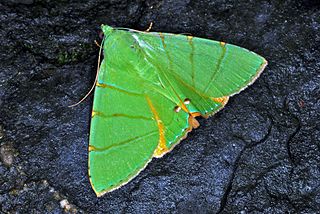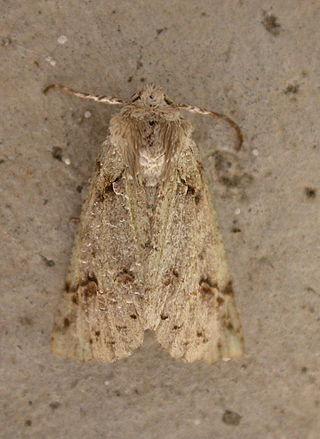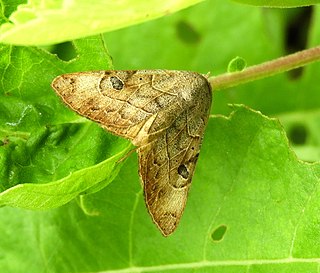
The Calpinae are a subfamily of moths in the family Erebidae described by Jean Baptiste Boisduval in 1840. This subfamily includes many species of moths that have a pointed and barbed proboscis adapted to piercing the skins of fruit to feed on juice, and in the case of the several Calyptra species of vampire moths, to piercing the skins of mammals to feed on blood. The subfamily contains some large moths with wingspans longer than 5 cm (2 in).

Eulepidotis is a genus of moths of the family Erebidae erected by Jacob Hübner in 1823.

Marimatha is a genus of moths of the family Noctuidae. The genus was erected by Francis Walker in 1866.

Declana is a genus of moths in the family Geometridae that is endemic to New Zealand. The genus was erected by Francis Walker in 1858.

Isogona scindens is a species of moth of the family Erebidae first described by Francis Walker in 1858. It is found from the southern parts of the United States to Paraguay and on Saint Kitts, Antigua, Grenada, Jamaica, Cuba, Hispaniola and Saint Croix.
Antiblemma imitans is a moth of the family Noctuidae first described by Francis Walker in 1858. It is found in Honduras and French Guiana.
Eulepidotis modestula is a moth of the family Erebidae first described by Gottlieb August Wilhelm Herrich-Schäffer in 1869. It is found on Saint Kitts, Dominica, Grenada, the Bahamas, Jamaica, Cuba, Puerto Rico, St. Croix, as well as in Ecuador.

Eulepidotis alabastraria is a moth of the family Erebidae first described by Jacob Hübner in 1823. Many former members of the moth family Noctuidae are classified in the family Erebidae now, along with all of the former members of the families Arctiidae and Lymantriidae. This re-classification has not yet met with general consensus, and many resources and publications still follow the older classification scheme. It is found from the southern part of the United States to Central and South America.
Eulepidotis caeruleilinea is a moth of the family Erebidae first described by Francis Walker in 1858. It is found in the Neotropical realm, including French Guiana, Costa Rica and the Brazilian states of Amazonas and Rio de Janeiro.
Eulepidotis colleti is a moth of the family Erebidae first described by Jérôme Barbut and Bernard Lalanne-Cassou in 2011. It is found in the Neotropics, including French Guiana.

Eulepidotis dominicata is a moth of the family Erebidae first described by Achille Guenée in 1852. It is found in the Neotropics, including Costa Rica, Brazil, Peru, Guyana and Ecuador. Reports from Texas and Florida are unconfirmed.
Eulepidotis detracta is a moth of the family Erebidae first described by Francis Walker in 1858. It is found in the Neotropics, including Brazil.
Eulepidotis merricki is a moth of the family Erebidae first described by William Jacob Holland in 1902. It is found in Jamaica, Cuba, and Puerto Rico. The species was originally described after being observed in the US state of Pennsylvania, but the specimen was probably imported with tropical fruit. The species is not present in the Nearctic.

Eulepidotis superior is a moth of the family Erebidae first described by Achille Guenée in 1852. It is found from Mexico to Panama and Venezuela, Colombia and Ecuador, as well as on Puerto Rico, Grenada and Saint Lucia.
Eulepidotis perducens is a moth of the family Erebidae first described by Francis Walker in 1858. It is found in the Neotropics, including Jamaica and Guyana.

Eulepidotis santarema is a moth of the family Erebidae first described by Francis Walker in 1865. It is found in the Neotropics, including the Brazilian state of Amazonas and Guyana.
Eulepidotis scita is a moth of the family Erebidae first described by Francis Walker in 1869. It is found in the Neotropics.








